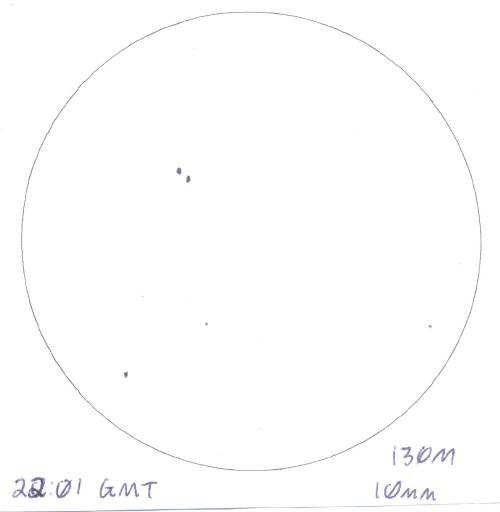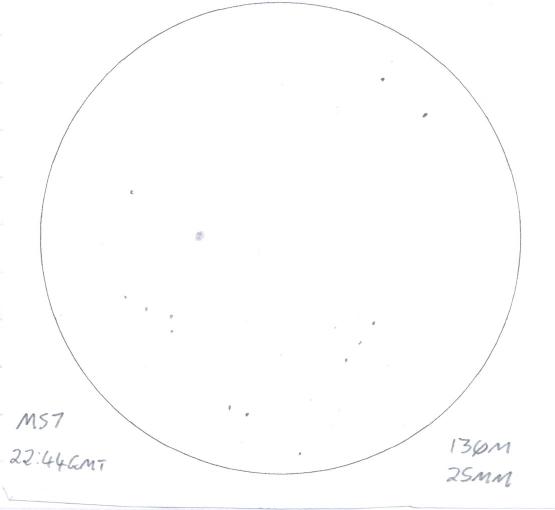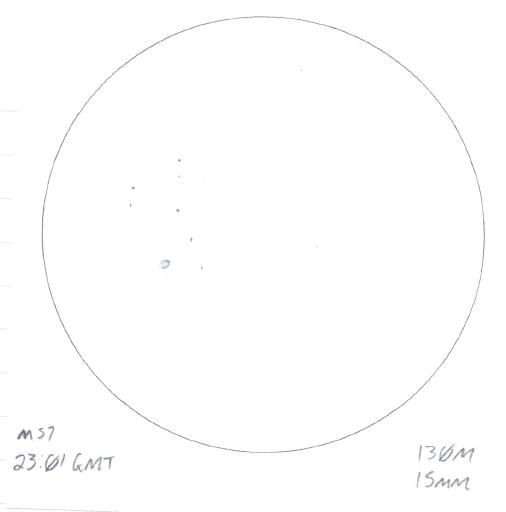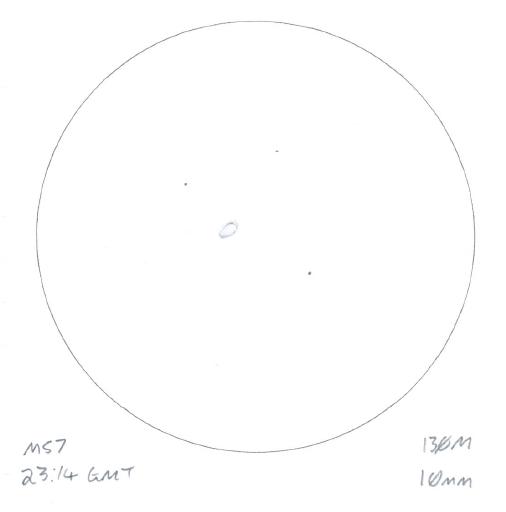2005-07-12
| Location: | Billingborough (South Lincolnshire, UK) |
| From: | 2005-07-12 20:17 UT |
| To: | 2005-07-12 23:23 UT |
| Equipment: |
Sky-Watcher Explorer 130M
|
| Notes: |
Reasonable evening's observing. Started out while the sky was still very light (not even sure that the Sun had set when I first set up) because I wanted to align and test the new Red-Dot Finder that I'd purchased from Scopes'n'skies. Also wanted to try the chance to test out a set of Lunar Filters that I'd recently purchased. Despite there being a fair bit of high-level "misty" cloud kicking about I stayed out for quite a while with a view to trying to see M57. |
Align and test Red-Dot Finder
| Time: | 2005-07-12 20:17 UT |
|
It took a while to get the finder properly aligned — I originally made the mistake of trying to use a reasonably distant object on the horizon but when I then tried to use the finder to line up on the Moon I just wasn't getting it. Finally gave up on that I used the Moon as the alignment target. That worked a treat. After the alignment I slewed the 'scope away from the Moon and used the finder to get me back on it. The Moon was in the eyepiece (25mm) first time. Very impressed with the finder, it's so much easier to use than the finder that came with the 130M. |
The Moon and aborted filter test
| From: | 2005-07-12 20:27 UT |
| To: | 2005-07-12 20:42 UT |
|
Started to have a proper look at the Moon with the 25mm eyepiece. Noted that the image was quite unsteady even at this low magnification. This probably had as much to do with tube-currents as anything else given that the telescope was still very warm and I'd not been out that long. Around 20:42 UT, just as I'd attached the ND25 filter to the 25mm eyepiece and reinserted the eyepiece into the telescope, I started to lose the Moon behind the house nextdoor so I had to give up on that test. |
Jupiter, testing new finder and ND25 filter
| From: | 2005-07-12 20:50 UT |
| To: | 2005-07-12 21:11 UT |
|
Noticed that I could now see Jupiter with the naked eye so decided to use this as a second target for testing the new finder. Lined up with the finder and then looked through the 25mm eyepiece. Almost spot on first time! Took the opportunity to fine-tune the alignment against Jupiter. Switched to the 6mm eyepiece but found it hard to get reasonable focus and the image was very unsteady (again, probably tube-currents combined with unsteady air in general and seeing not being terribly good). Added the ND25 filter to the 6mm eyepiece and, surprisingly, found that it seemed easier to pick out a good point of focus. At 21:11 UT Jupiter was obscured by a cloud. |
Summer Triangle
| Time: | 2005-07-12 21:12 UT |
|
Noticed that, while the sky was still quite light, and while there was some thin cloud above me, I could now clearly see the Summer Triangle. Also noted that Arcturus was easily visible. |
Jupiter
| From: | 2005-07-12 21:20 UT |
| To: | 2005-07-12 21:22 UT |
|
Jupiter became visible again. Went back to it with the 10mm and 2x barlow. This time the image was reasonable. The two main belts were obvious and I also noticed a moon very close to the planet. At 21:22 UT I started to make a sketch of Jupiter and its moons but I lost it behind the house nextdoor so the sketch didn't get finished. |
Testing effect of filters on a star
| From: | 2005-07-12 21:37 UT |
| To: | 2005-07-12 21:50 UT (approximate) |
|
Decided to test the effect of the ND25 and ND13 filters on a bright star. Selected Deneb as a suitable target. Using the 10mm eyepiece on its own the star seems to be "too bright" to see well. There is an obvious four-pointed flare caused by the spider in the scope. With the addition of the ND25 filter things get a lot better. While I can still see the flare caused by the spider it is nowhere near as obvious as it is without the filter. With the ND13 there is no flare at all. It is, however, obvious that I'm not seeing a pin-point of light. I suspect that this comes down to a number of things: collimation (still need to get around to making a habit of doing this), possible lingering tube currents, a general unsteadiness of the atmosphere and the fact that there is still a hint of high-level haze around. Based on that little test I get the impression that the ND25 and ND13 filters might come in handy when trying to split a reasonably close and reasonably bright binary. |
Mizar in Ursa Major
| From: | 2005-07-12 22:00 UT |
| To: | 2005-07-12 22:26 UT |
|
Had another look at Mizar again. While doing so I noticed a 4th star very close that I'd not noticed last time. Checked with Starry Night it seems that it is TYC3850-257-1, a magnitude 7.56 star. I noted this down because it's interesting that I didn't seem to notice it last time Did a rough sketch of what I saw: Also note the faint star to the far right of the sketch. Not sure what that is; I need to check. It would estimate that it is somewhat fainter than TYC3850-257-1. Checking later with Starry Night it is TYC3853-654-1, a magnitude 9.56 star. At 22:26 UT, just as I was finishing up the above and removing the 10mm eyepiece from the telescope, I managed to drop the eyepiece onto hard paving! Blast! As best as I could tell it didn't damage the eyepiece although it did leave a rather nasty looking scuff mark on the metal barrel. |
Finding M57
| From: | 2005-07-12 22:31 UT |
| To: | 2005-07-12 22:44 UT |
|
Decided to go looking for M57 (the Ring Nebula) in Lyra. First lined up in the general area using the new Red-Dot finder then looked through the telescope itself with the 25mm eyepiece. Nothing immediately stood out. However, while initially looking, a satellite passed right through the field of view. I turned round to look with the naked eye but couldn't see it at all. Back at the telescope, I moved the field of view around a little and almost immediately saw what I thought must be M57. My initial impression was that, in contrast to the stars in the field, there was a faint, ghostly gray "blob". Noted that I could only see it with averted vision. With the 25mm eyepiece there didn't appear to be any hint of it being an actual ring (this might not have been helped by the fact that the sky still wasn't fully dark and that there was still some high-level haze about). Made a rough sketch of what I could see, marking some of the brighter stars I could see in the field. This was made a little difficult by the field being partially obscured from time to time by some of the cloud/mist: |
M57 with 15mm eyepiece
| From: | 2005-07-12 22:52 UT |
| To: | 2005-07-12 23:01 UT |
|
Switched to the 15mm eyepiece. With averted vision a good hint of the ring structure could be seen. A couple of minutes into looking at it another satellite went through the field. There's no obvious hint of any colour to the ring, although with the 15mm eyepiece (compared to the 25mm eyepiece) it did seem to be more of a faint "bluish gray" rather than just gray. Also noticed that the nebula seemed to be very elongated in one direction. At around 23:01 UT I made the following sketch of what the nebula looked like with the 15mm eyepiece (note that, again, I simply marked some of the more obvious stars in the field for reference): |
M57 with 10mm eyepiece
| From: | 2005-07-12 23:08 UT |
| To: | 2005-07-12 23:23 UT |
|
Switched to the 10mm eyepiece. The ring structure was now very obvious (again, with averted vision). It seemed much less "blueish". The center doesn't seem as dark as the background sky but it is obviously darker than the edge of the nebula. Around 23:14 UT started the following rough sketch: By 23:23 UT it was starting to get very misty so started to pack up for this session. |



